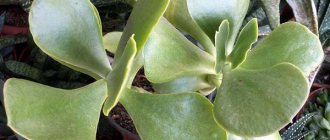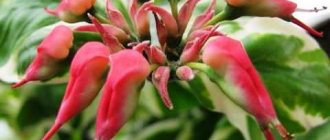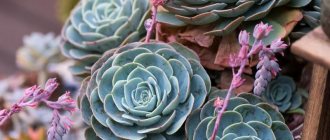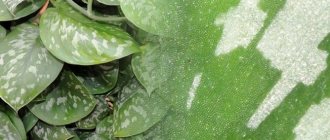Features of the plant
The leaves are unusually juicy and fleshy, decorated with decorative spots. With a lack of sunlight, a succulent may lose such a specific ornament, turning into a monochromatic one.
The peduncle is thrown high up to 40 cm, and on it is an inflorescence-spike. Making a bush bloom is difficult even in a greenhouse, and even more so in indoor conditions. But the representative of the Crassulaceae family is more valued not for its small, inconspicuous flowers, but for the unusual shape of its leaves.
Description of the plant
Adromiscus is a favorite among gardeners. They are attracted to perennial leaves. And to be more precise, their shape and shade. They are triangular. They can be either green or bright red.
They are quite easy to care for. Therefore, owners can only admire their unusual beauty. Translated from Greek, “adromiscus” means “thick stem.” The height of Adromiscus reaches fifteen centimeters. It was first found in Africa. At the moment, you can meet him both in the south and southwest of this continent.
Home care
Adromiscus is accustomed to life in the desert, so its conditions should be kept as close to arid as possible. A lot of light, warmth, low air humidity, infrequent watering and protection from drafts in winter will help this succulent feel at home in your apartment and reward you with its decorative value for your care.
Advanced flower growers boldly experiment, planting several micro bushes in one pot for greater beauty. If you decide to repeat their experiment, do not plant different types of Crassulaceae in the same pot. It is better to alternate one type of Adromiscus with aizoonaceae.
Location and lighting
The desert dweller Adromiscus is not afraid of the sun, so you can safely place it in a south window. South-east and south-west placements are also suitable. There is no need to shade, but be sure to provide ventilation, otherwise the fleshy leaves may get burned. If the balcony faces the sunny side, be sure to place the succulent there for the summer.
Temperature
In the warm season, it is advisable to provide the plant with a temperature within +25-27°C. If the thermometer rises to 30 degrees, be sure to create a slight draft so that the leaves do not burn.
In winter it can withstand +8-12°C. If the temperature drops to 7 degrees or lower, Adromiscus may die.
Watering
Like any succulent, the bush is not particularly spoiled by moisture. Therefore, water it sparingly. Until the soil dries, do not add life-giving moisture. Even if the soil outside is dry, wait another 4-6 days before watering.
In winter you need to do this even less often. If the room is cool, you can stop watering altogether for a while.
Do not use cold water, take only soft water and always at room temperature. Before watering, the water must settle.
Air humidity
There is no special need to increase the air humidity in the room, since Adromiscus prefers dry air. Since the leaves are able to accumulate moisture, there is no need to spray the plant either.
The soil
Soil for Adromiscus can be purchased at the store. Choose soil for cacti or succulents. You can play it safe by adding charcoal or river sand to the mixture to improve the health of the roots. Be sure to line the bottom of the pot with a thick layer of drainage.
If you want to prepare the soil mixture yourself, mix the following ingredients:
- coarse sand (30%);
- garden soil (20%);
- humus (20%);
- charcoal (10%);
- bone meal (10%);
- lime (10%);
- some eggshells.
Heat all the ingredients in the oven, let cool and mix well.
Feeding and fertilizers
In winter, leave the bush alone. And, starting from March and until the end of summer, add fertilizer once a month. Choose for cacti and succulents.
Transfer
Adromiscus does not need to be replanted very often. Do this approximately once every two years. When you notice that it feels cramped in the old pot and the roots are protruding from the drainage holes, replant it. It is advisable to begin action in the spring.
Take a wide, low pot. Line the bottom with drainage. The layer of pebbles should be at least 5 cm. Sprinkle the soil mixture on top, adding brick chips or coals.
Do not water the plant for a couple of days. Using a knife, carefully scrape the soil away from the edges of the pot. Pull out the bush and, together with the earthen lump, transfer it to a new place, without burying the stem too deeply. Do not overwater the plant to prevent the roots from rotting.
Immediately transplant the purchased representative of the Tolstyankov family into a new bowl. Keep it in a cool, unlit place for several days without watering. And after transplanting, move it to a sunny windowsill and resume watering.
Trimming
After flowering has finished, give the succulent a little rest. Only after 2-3 weeks, cut off the dried stems on which there were buds. This should be done with a sharp knife, previously wiped with alcohol.
Adromiscus care
This plant does not have strict care requirements, so caring for Adromiscus is not that difficult. Firstly, it requires constant lighting. In this case, you must carefully ensure that the leaves do not fall into direct sunlight. After all, burns can form.
The temperature in the room should be thirty degrees. In cold weather the temperature can drop to ten degrees. If the temperature is lower, the plant will most likely die.
Adromiscus does not really like spraying. Water can cause rot. It will also increase the risk of burns on the leaves. If there are damaged parts, they must be removed immediately.
Reproduction
There will never be any problems with the propagation of this plant. You can propagate by cuttings, individual leaves, dividing the bush and leaves. If you do this in the spring and not in the summer, you will be able to preserve all varietal characteristics.
Propagation by sheets
Cut off the thickest leaves from the bush. Place in a cool, dark place for 3-4 hours. Then plant it in the ground for cacti. Deepen the leaves by 2 cm. Cover the pot with film and place in a warm place, hidden from sunlight.
Don’t forget to moisten the soil every day and remove the plastic to ventilate. Remove the cover immediately after new leaves appear. In about a month, rooting will occur.
Propagation by seeds
Only seasoned flower lovers can use this method with a successful outcome. The process is complex and lengthy, so if you are not sure, it is better not to take risks. Pour the soil into the prepared container and level it. Scatter the seeds evenly, sprinkle with sand and cover with glass on top. Keep at a temperature not lower than 20 degrees.
Shoots should appear in approximately two weeks. After the sprouts grow, plant them in separate pots. Bushes grown in this way will bloom in 2-3 years.
Dividing the bush
In this matter, it is important to maintain sterility, so before starting work, disinfect the instruments, otherwise bacteria will immediately attack the cut sites, which can kill your patient.
Cut a piece of the root with a sharp knife, let it dry, sprinkled with charcoal. Plant in prepared moist soil, sprinkled with soil. Install close to the window. Water only with slightly warmed, settled water.
Propagation by cuttings
After cutting out a leaf rosette, keep it in a dark place, and then plant it in a container with vermiculite. After the roots appear, transplant into separate 7-centimeter pots.
Plant propagation
The reproduction process is simple. To do this, you will need cuttings or specially selected mature leaves . Even accidentally fallen leaves take root quickly due to the high moisture content.
The most suitable time for reproduction is late spring. It is better to take large leaves in the middle of the stems. They can be dried a little by spreading them on paper . Then place the base towards the surface of the earth. Ensure sustainability. After a while, young pagons will appear at the place where the old leaves were cut. And the planting material dries out over time.
This video shows one of the methods of propagation of Adromiscus.
Diseases and pests
Adromiscus can be annoyed by aphids, mealyworms, and spider mites. This happens rarely, but when you notice pests, first wipe the leaves with a piece of cloth soaked in ethyl alcohol. After this, treat with garlic or wormwood infusion. You can also use store-bought insecticides.
Care errors
If you make mistakes in caring for Adromiscus, the plant will immediately give signals. The main thing is to decipher them correctly and take urgent measures to eliminate the shortcomings.
The dying and yellowing of the lower leaves should not scare you. This is evidence of old age. But the appearance of rot indicates moisture getting into the outlet.
If the top leaves turn yellow and dry out, it means that you either overwatered the plant or suffered a sunburn. Overwatering can still rot the roots. If such a situation arises, cut the cuttings and plant them, but the old bush will have to be destroyed - it will not be possible to save it.
Leaves crack due to too infrequent watering. If the shoots are stretched out and the leaves are faded, it means that the plant does not have enough light.
Problems when growing andromiscus
Andromiscus rarely causes problems to its owners, because has sufficient resistance to diseases. But regular inspection of the plant is necessary. Possible diseases and problems:
| Causes | Manifestations | Corrective Action |
| Aphid | The leaves completely lose moisture, dry out and curl. Then they fall off, which can lead to the death of the plant. | Spray both the flower and the ground with tobacco decoction mixed with a soap solution or aerosol insecticide Fitoverm, Fufan. |
| Chervets | Appears on the roots, occasionally on the ground part. The plant becomes covered with white lumps that look like cotton wool. | They are treated with Aktar and Confidor. Repeat at least 3 times, every 5-7 days. |
| Spider mite | The leaves are entangled in small cobwebs. The affected areas turn yellow, close to other parts of the plant, dry out and die. | Intavir, Karbofos, Actellik are applied generously. |
In some cases, the plant dies for no apparent reason. This usually happens due to improper watering, water getting into the flower rosette, or, conversely, the soil completely drying out. If the leaves have faded, the stem stretches - there is not enough lighting.
Adromiscus species
In total, there are about fifty species of Adromiscus in the wild, but only a few of them are cultivated indoors. Let's look at the distinctive features of the most popular ones.
Adromis chuscristatus
The young plant has erect stems. But over time they begin to sag and fall apart. As it grows, aerial roots grow. The leaves, collected in rosettes, are dark, convex, wavy with a slight edge. To make them dense and reach a centimeter thickness, you will have to try hard. The buds bloom greenish-white with pink edges.
Cooper's Adromiscus (Adromischus cooperi)
The shoots spread below, and oval glossy green leaves with wavy edges, decorated with brown streaks, are attached to them. Red-green tubular flowers in the form of a spike are framed along the edges with white, purple or scarlet color. The most unpretentious species from the Crassulaceae family.
Poellnitz's Adromiscus (Adromischus poellnitzianus)
A tiny 10-centimeter bush with branched dark green shoots, generously decorated with brown hair. The stems are convex at the bottom, and become flat closer to the top. Whitish hairs can be seen on the surface. Pellnitsa throws out a high 40-centimeter arrow with small, not very beautiful flowers at its top.
Spotted Adromiscus (Adromischus maculatus)
A weakly branching specimen with large rounded leaves decorated with brown-red spots on both sides. The low bush blooms creamy-purple. The buds are not too pretty. This species is valued for its decorative leaves.
Adromischus trigynus
The low succulent is distinguished by thick, rather long shoots. Branches well. Brown spots are scattered across the dark rounded leaves. The flowers are unattractive red-brown in color.
Adromiscus marianaeherrei
The red leaves have an unusual texture reminiscent of volcanic lava. A very light-loving bush. In shade or partial shade it can lose its bright color, changing the color of the leaves to normal green. In addition, without the sun it will stretch unattractively upward. It grows very slowly. It has several subspecies, differing in leaf shape.
Feel free to start growing this ornamental plant, even if you are new to floriculture. Create conditions for Adromiscus that are as close to desert conditions as possible, and then you will not have problems growing this wonderful succulent.
Growing adromishus
Outdoors they grow in fertile, well-drained soil. Many types of this succulent can be easily grown indoors in sandy soil. You can plant such a miniature plant not only in an ordinary pot. A florarium or other decorative container (an old pot, shell, etc.) is perfect for adromishus. The main thing is that there are holes in the bottom for water to drain.
Place of cultivation
To grow adromishus, choose a well-ventilated, illuminated place. The plants grow well on a sunny windowsill or the top shelf of a greenhouse as they need plenty of light. Without sufficient lighting, the leaves of the succulent will fade, however, due to prolonged exposure to radiation, they can wrinkle, so here you need to find a middle ground. It is important to ensure that the flowerpot is not exposed to the scorching sun for many hours in a row.
Adromischus thrive in warm conditions (ideal 24-30°C) but can withstand even low temperatures of 5-10°C.
Note! In winter, you need to move the plant to a protected place, primarily so that it does not get wet. Stagnation of water between leaves can be fatal.
Soil and fertilizer
To grow in the garden, you need loose, well-drained soil, such as a mixture of peat and sand with a small amount of gravel added. Stores sell special soil for succulents or cacti.
To prepare suitable soil with your own hands you will need: 3 parts sand (perlite), 2 parts garden soil, 2 parts humus, 1 part charcoal, a little lime or crushed eggshells. You can put a layer of stones on the bottom of the pot before adding soil.
Fertilizer is recommended only during transplantation or the growing season. There is no need to fertilize the plant in winter.
Watering
Since succulents tend to accumulate water, they can go for long periods without watering. From spring to autumn, it is enough to water the plant once/2 weeks. In order for Adromishus to withstand the winter, it needs special conditions. In December-January there is no need to water the plant at all; in November and February it is enough to do it once.
Important: do not pour water on the stem of adromishus, otherwise it will rot!
If the leaves begin to crack, then the plant does not have enough moisture.
Diseases, parasites
This type of succulent rarely suffers from parasites or disease. Small pests (aphids, mealyworms) can be destroyed using systemic insecticides.
Overwatering may cause the plant to rot. In this case, you need to remove it from the pot, then separate the rotten areas. Before planting, wash the roots with a weak solution of potassium permanganate.
Transfer
Adromishus have a small height, but have high ground cover properties. Repotting does not help increase the size of the plant (except in width), but it does benefit its health. If the succulent no longer fits in the pot, then you should choose a slightly larger container, given that it will not grow much.
Replanting is recommended in the spring, when the adromishus has finished its dormant period. There is no need to water it a couple of days before the procedure and a few more days after it.
Watering Adromiscus
It is necessary to water the plant no more than once or twice a month. The soil must have time to dry out thoroughly. Water is carefully poured into a tray, along the edge of the pot or at a distance from the flower itself. Excess moisture causes various diseases or rotting of the roots.
The most favorable ambient temperature ranges from twenty-nine to thirty-three degrees above zero. In winter, the temperature should not fall below eleven degrees above zero. As soon as the temperature drops below eight degrees, the plant dies. For the winter, garden succulents are moved to a well-heated room.
Planting/growing
Adromiscus spotted, like a houseplant, is unpretentious and does not require intensive care. Replant the flower in spring in small containers. You can use ready-made soil (substrate for cacti or succulents). If you prepare the soil yourself, you should mix in equal proportions: peat, sand and fine expanded clay (or vermiculite). The acidity of the soil should be neutral (pH - 6.0-7.0), good drainage should be ensured. In order not to cause rotting of the roots, when planting, you should not deepen the plant stem too much.
Kinds
Cooper's Adromiscus
Bibliography:
- Cacti and succulents: Illustrated Encyclopedia / Anderson M. - M.: Niola 21st century, 2002, - 264 pp.: ill.
- Agaves, aloe and other succulents / Udalova R.A. - St. Petersburg: Agropromizdat, 1994. - 112 p.: ill.
- Thorn: how to create a green oasis at home. Amazing cacti and succulents / Zhinel Leon. — M.: Eksmo, 2022.— 224 p.: ill.
Adromiscus transplant
These plants grow quite slowly, so they can grow well in the same pot for years. If your Adromiscus plants begin to noticeably increase in size, you can replant them in a container that is slightly larger than their current one. Fill the pot with fresh suitable soil and carefully replant the succulent. The best time to repot is when they begin their new growth in the spring or fall, which gives them time to adjust to winter. Although, if you are careful not to damage the roots, you can replant adromicus most of the year. Damage to the roots in winter can cause rot after repotting and remember that Adromiscus should always be planted in a pot with drainage holes in the bottom.











